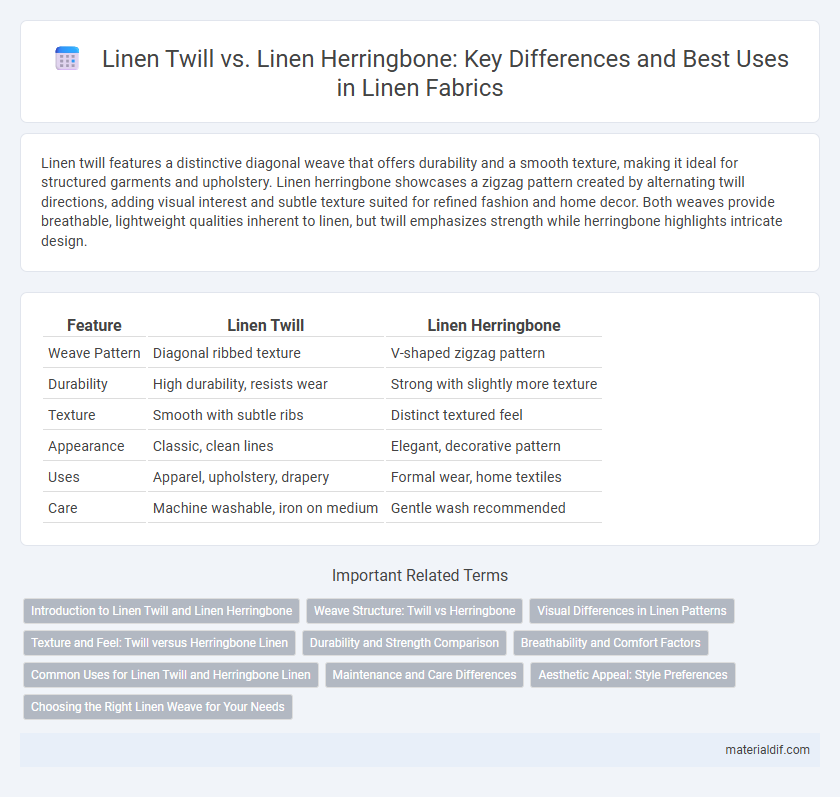Linen twill features a distinctive diagonal weave that offers durability and a smooth texture, making it ideal for structured garments and upholstery. Linen herringbone showcases a zigzag pattern created by alternating twill directions, adding visual interest and subtle texture suited for refined fashion and home decor. Both weaves provide breathable, lightweight qualities inherent to linen, but twill emphasizes strength while herringbone highlights intricate design.
Table of Comparison
| Feature | Linen Twill | Linen Herringbone |
|---|---|---|
| Weave Pattern | Diagonal ribbed texture | V-shaped zigzag pattern |
| Durability | High durability, resists wear | Strong with slightly more texture |
| Texture | Smooth with subtle ribs | Distinct textured feel |
| Appearance | Classic, clean lines | Elegant, decorative pattern |
| Uses | Apparel, upholstery, drapery | Formal wear, home textiles |
| Care | Machine washable, iron on medium | Gentle wash recommended |
Introduction to Linen Twill and Linen Herringbone
Linen twill features a distinctive diagonal weave that enhances durability and adds subtle texture, making it ideal for garments requiring both strength and comfort. Linen herringbone, characterized by its V-shaped zigzag pattern, offers a refined and sophisticated appearance while maintaining the natural breathability and softness of linen fibers. Both weaves highlight linen's inherent moisture-wicking properties and lightweight feel, catering to different aesthetic and functional preferences.
Weave Structure: Twill vs Herringbone
Linen twill features a distinctive diagonal weave pattern that offers durability and a smooth texture, making it ideal for garments requiring strength and flexibility. Linen herringbone showcases a broken zigzag pattern created by alternating directions of the twill weave, providing a sophisticated visual texture and enhanced fabric stability. The twill weave emphasizes consistent diagonal lines, while the herringbone weave incorporates a reversed twill pattern that forms a characteristic V-shaped motif.
Visual Differences in Linen Patterns
Linen twill features a diagonal weave pattern that creates a smooth, consistent texture with subtle ridges, making it ideal for garments requiring durability and a classic look. Linen herringbone showcases a distinctive V-shaped zigzag pattern, resulting from alternating twill directions, which adds a dynamic, structured visual interest to fabrics. The visual difference lies in twill's straightforward diagonal lines versus herringbone's more complex zigzag pattern, both enhancing linen's natural texture but offering contrasting styles for fashion and home decor.
Texture and Feel: Twill versus Herringbone Linen
Linen twill features a diagonal weave that creates a smooth, durable texture with a subtle sheen, offering a soft yet structured feel ideal for garments demanding resilience. Linen herringbone exhibits a distinctive V-shaped pattern resulting in a textured surface that feels more tactile and visually dynamic, providing a heavier, more substantial hand. Twill linen is generally lighter and more breathable, while herringbone linen offers enhanced texture and depth, making it perfect for sophisticated upholstery or outerwear.
Durability and Strength Comparison
Linen twill features a diagonal weave that enhances fabric durability and resistance to wear, making it stronger for heavy use compared to linen herringbone. Linen herringbone, characterized by its distinctive V-shaped pattern, offers moderate strength but excels in flexibility and softness. For applications demanding maximum durability and robust structure, linen twill is the preferred choice over linen herringbone.
Breathability and Comfort Factors
Linen twill features a distinctive diagonal weave that enhances durability while maintaining excellent breathability, making it ideal for warm climates. Linen herringbone's V-shaped pattern offers a slightly denser structure, which may reduce airflow but provides superior softness and drape for increased comfort. Both fabrics excel in moisture-wicking properties inherent to flax fibers, ensuring a cool and comfortable wear experience.
Common Uses for Linen Twill and Herringbone Linen
Linen twill is commonly used for apparel such as tailored pants, jackets, and uniforms due to its diagonal weave that provides durability and a smooth finish. Herringbone linen, characterized by its distinctive V-shaped pattern, is often chosen for formalwear like blazers and suits, as well as home textiles including upholstery and curtains for its decorative texture. Both fabrics are valued in fashion and interior design for their breathable, lightweight qualities and elegant appearance.
Maintenance and Care Differences
Linen twill fabric features a diagonal weave that enhances durability and hides wrinkles better than linen herringbone's distinctive V-shaped pattern, which requires more frequent ironing to maintain its textured appearance. Linen twill typically withstands machine washing and gentle tumble drying, while linen herringbone benefits from air-drying and occasional dry cleaning to preserve its delicate structure. Both fabrics demand prompt stain treatment and ironing while damp for best results, yet linen herringbone often requires more careful handling to avoid damage to its intricate weave.
Aesthetic Appeal: Style Preferences
Linen twill features a distinctive diagonal weave that creates a smooth, lustrous surface, offering a classic yet casual aesthetic ideal for modern wardrobes. Linen herringbone, characterized by its zigzag pattern, provides a textured, sophisticated look favored in tailored garments and formal settings. Style preferences lean towards linen twill for versatile everyday wear, while linen herringbone appeals to those seeking a refined, elegant finish.
Choosing the Right Linen Weave for Your Needs
Linen twill offers a sturdy, diagonal weave ideal for durable clothing and upholstery, while linen herringbone features a distinctive V-shaped pattern that adds texture and visual interest, perfect for more stylish or formal applications. Choosing between linen twill and linen herringbone depends on your need for durability versus aesthetic appeal, with twill excelling in strength and herringbone enhancing sophistication. Consider factors like fabric weight, weave tightness, and end-use to select the linen weave best suited for comfort, longevity, and design impact.
Linen Twill vs Linen Herringbone Infographic

 materialdif.com
materialdif.com